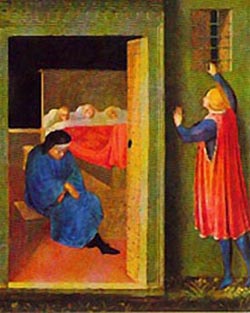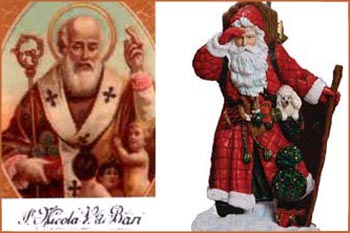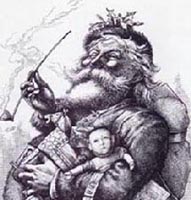 |
The Saint of the Day
St. Nicholas, December 6
Prof. Plinio Correa de Oliveira
Biographical selection:
St. Nicholas is said to have been born at Patara in Lycia, a province of Asia Minor, in the 4th century of wealthy parents. He was named Bishop of Myra, and became famous for his holiness, charity and miracles. He was imprisoned for his faith during the persecution under Diocletian. He was present at the Council of Nicaea, at which he denounced Arianism. He died at Myra in 350. In 1087 some of his relics were transferred to Bari, Italy, and many miracles were worked through his intercession, which was the cause of his extraordinary popularity in the West.
Comments of Prof. Plinio:

Fra Angelico painted St. Nicholas throwing a bag of gold in the window of the sleeping father of three daughters |
Taking advantage of the wealth of his parents, St. Nicholas would give gifts to those who are called the 'embarrassed poor,' that is, persons of a good social level who cannot beg on the streets for help but lack financial means to live. St. Nicholas used to find different ways to favor such impoverished persons, leaving gifts anonymously via a window, chimney or various other means.
A characteristic case is that of the father with three daughters who could not provide them with dowries and arrange decent marriages for them. In despair, the man was thinking that their only recourse was to lead lives of shame. On three different occasions, St. Nicholas threw bags of gold into his house, thus enabling him to provide each daughter with a dowry so she could marry well.
From this and his many other charitable works came the general idea that he would come from Heaven on Christmas Eve and give presents to well-behaved children. This was a good legend that was widely spread in Catholic countries, and quickly caught on in other countries as well. It was a stimulus for children to be Catholic, to be good and, at the same time, it nourished their innocence and sense of the marvelous.
The enemies of the Church, however, could not support the popular fame of St. Nicholas among children and invented another figure to divert their attention.

The secret forces in France transformed the traditional St. Nicholas into the secular figure of Pere Noel, right |
In France, the secret forces created the figure of Pere Noel. The title of Pere (father) is a very common title given to old men who have a kind of patriarchal role among the simple people. The word Noel is an exclamation of joy, similar to Alleluia, normally reserved for the festivities of Christmas, although not exclusively. Thus, they invented the figure of Pere Noel, who would do precisely the same as St. Nicholas, but who was no longer a reflection of Catholic charity and sanctity.
Instead, he represented a kind of philanthropy without a religious foundation, without the highest cause. This was the way the religious legend of St. Nicholas became a profane, or secular, legend in France.

Santa Claus by Thomas Nast in Harper's Weekly (1881) |
The Protestants, who hated the cult of the saints, substituted the legend of St. Nicholas or St. Claus with the legend of a Nordic magician. Then they mixed many characteristics of the magician - the sleigh, reindeer, etc. - together with the life of St. Nicholas to deviate the admiration of the children from a religious figure to a phantasy.
It was an intelligent way the Revolution used to eliminate the Catholic character of this legend that was a most charming Catholic tradition.
It is useful for us to learn how evil works against Catholic traditions even in details that can appear insignificant. Then, with vigilance, we should discern its advance and oppose it.


Watch a video illustration of this Saint of the Day article
here

  | | Prof. Plinio Corrêa de Oliveira | |
The Saint of the Day features highlights from the lives of saints based on comments made by the late Prof. Plinio Correa de Oliveira. Following the example of St. John Bosco who used to make similar talks for the boys of his College, each evening it was Prof. Plinio's custom to make a short commentary on the lives of the next day's saint in a meeting for youth in order to encourage them in the practice of virtue and love for the Catholic Church. TIA thought that its readers could profit from these valuable commentaries.
The texts of both the biographical data and the comments come from personal notes taken by Atila S. Guimaraes from 1964 to 1995. Given the fact that the source is a personal notebook, it is possible that at times the biographic notes transcribed here will not rigorously follow the original text read by Prof. Plinio. The commentaries have also been adapted and translated for TIA's site.
|
Saint of the
Day | Home | Books
| CDs | Search
| Contact Us | Donate

© 2002- Tradition in Action, Inc. All Rights Reserved
|
 |

|